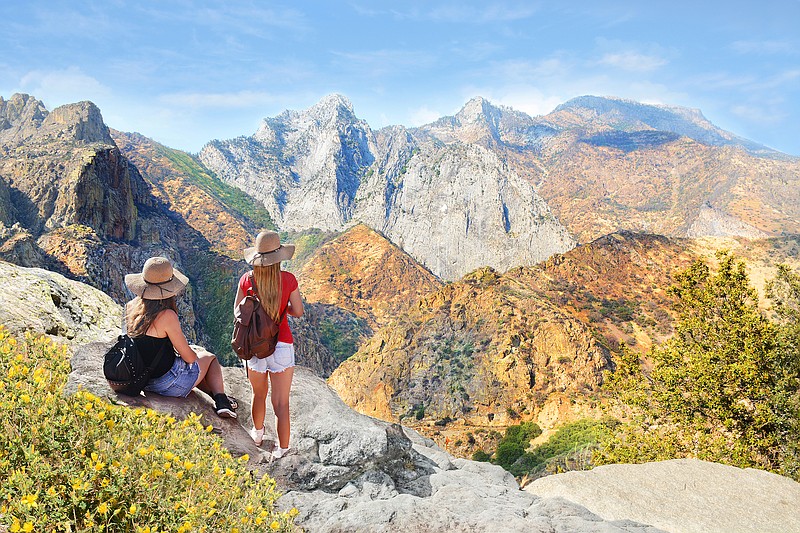LOS ANGELES -- How do hikers balance the tricky -- and sometimes dueling -- objectives of ambition and contentment?
Most days, I'm simply content to be plodding along on my local San Gabriel Valley trails, grateful to have the time and luxury to hike. I'm not looking to hike Baldy this year; instead, I'm trying to listen to my body and brain -- and I know they're not ready.
But other times, there's an itching feeling that I'm not doing enough, or that I'll never be a "real hiker" -- and that feeling of inferiority can hit hard. When you're raised by hard-driving, achievement-based parents in a society that often values ticking checklists over deep engagement, you tend to have a sneaking suspicion that no peak will ever merit perfection; no accomplishment will ever offer the sweet reward of contentment.
As an outgoing extrovert and people pleaser, I find listening to myself a challenge. I want to stick with everyone on group hikes instead of paying attention to what my aching body or frustrated mind want.
In college, a dear friend loaned me a book that offered another perspective on activity. "The Miracle of Mindfulness" by Thích Nhat Hanh, a French-Vietnamese Buddhist monk, presented the idea that I could focus solely on what I was doing in that very moment, and by doing so, meditate without sitting down and closing my eyes. For instance, while washing the dishes, hone in only on washing the dishes, Nhat Hanh advises. The results of practicing mindfulness while washing dishes can be startling, as I learned.
At the time, I lived in a co-operative house, so I was scrubbing pots and pans that served 20. When I was able to practice mindfulness, I heard the clang of the pots as they hit the big aluminum wash basin, the forceful spray of the water. I felt the muscles in my arms flex as they lifted a heavy pot, and I smelled the peculiar mix of the dish soap and the remnants of a Jamaican black bean stew. I also felt a rhythm as my brain relaxed into the activity, losing itself in a flow state.
That's the elusive state I'm looking for when I'm hiking my local trails. When I hike mindfully, I often slow down naturally. Lost in the scents of herbs and wildflowers, gazing at the clouds and the rocks in the trail, I'm focused not on achieving hard things but on enjoying. Too often we seek to collect peaks, to reach the end, without enjoying -- as much as we can -- the beauties of the path up, challenges included.
Now, I've found companions in my quest (on, of all things -- of course -- TikTok): soft hikers.
The trend of soft hiking is a cousin of walking meditation, practiced in TikTok videos by influencers like softgirlswhohike. Insider reports that Brits Emily Thornton and Lucy Hird started the account to show that you can take it slow -- even meander -- and still call yourself a hiker, without worrying about imposter syndrome. Plus, if you practice soft hiking as walking meditation (here's more on how to do it), you could even reap the benefits of the latter: improved digestion, anxiety reduction and improved blood sugar levels and circulation.
So how do you keep accomplishing and scaling peaks, without losing sight of the softer side of hiking? I have a few thoughts.
1. Hike like nobody's watching. Social media can make you feel like you're inside the panopticon, always being watched and comparing your feats to those of others. Healthy competition is great, but if you struggle with shutting down achievement brain like I do, it can be helpful to turn off social media and keep your hikes to yourself.
2. Slow your roll and tune in to surrounding sights and sounds. Consciously slow down. Make it your goal to name 10 plants per hike, which requires leaning in and peering down at tiny growing things, or snapping a photo and identifying them. Try to name the birds or insects you see, or sketch trees in a journal. Plan for hikes that aren't straight up, that meander. Turn off your step counter and listen to an audiobook on your headphones, or just listen to nature itself. You can even record birdsong to identify later.
3. Bring a journal or recording device. Remembering your hike can bring deeper thoughts upon recollection, so consider capturing elements of the experience in a journal or recorder. This also gives you a moment to pause and reflect while you're doing your hike.
4. Choose the right companion. Hike with a friend who wants to slow down; a senior dog who's up for it is also a lovely slow-hiking pal. Catch up on life, and make the focus hiking side by side (look for trails wide enough for you to do so). Bring snacks so you can sit down and eat together.
5. Listen to your body. If your body is aching, don't push it. Leaving a group hike isn't quitting; it's listening to yourself. Friends can support you to achieve greater heights, but if you're not feeling the vibe of a particular trek, it's OK to leave. Give yourself permission to set boundaries and make individual decisions, even in a group setting.
6. Set aside time to stop and play. Open up your hike to childlike imagination. See a brook with stones you can hop across, or a log you can walk across? Do it. You've set aside a couple hours to be open to wherever the trail takes you; use the time to truly explore. Follow your intuition when it comes to what your mind craves, whether it's more stimulation or a moment of rest and relaxation.

